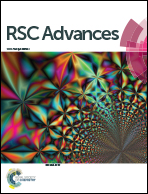Boosting the supercapacitive properties of polypyrrole with chitosan and hybrid silver nanoparticles/nanoclusters†
Abstract
We report a one-step route to hierarchical polypyrrole/chitosan decorated with hybrid Ag nanoparticles/nanoclusters (Ag@PPy/CS) via electrodeposition. The ternary nanocomposite electrode was applied as an electrode material for a supercapacitor. Experimental results showed that the ternary nanocomposite has a specific capacitance of 513 F g−1 at 0.2 A g−1, which was greatly improved from that of the PPy electrode (273 F g−1). The chitosan provided excellent hydrophilicity to the ternary nanocomposite, at the same time it controlled the growth of metallic Ag. The ultra-small Ag nanoparticles (1–2 nm) enhanced the electrical conductivity of the PPy while the Ag nanoclusters (30–80 nm) acted as spacers to prevent the restacking of the electrode films as well as contributing to the electrical conductivity. The as-assembled symmetric supercapacitor of the ternary nanocomposite delivered a specific capacitance of 183 F g−1 and outstanding cycling stability with 98.3% capacitance retention after 1000 charge/discharge cycles. Considering the facile preparation and moreover the exceptional electrochemical performance, the Ag@PPy/CS nanocomposite electrode could be well-suited for high-performance supercapacitors.



 Please wait while we load your content...
Please wait while we load your content...